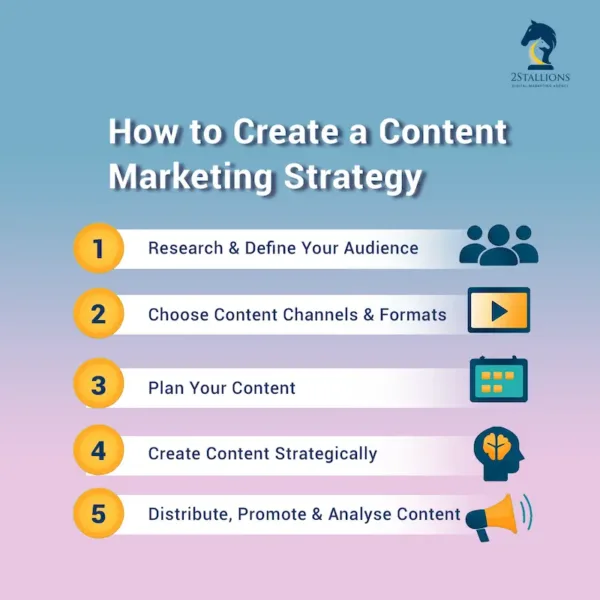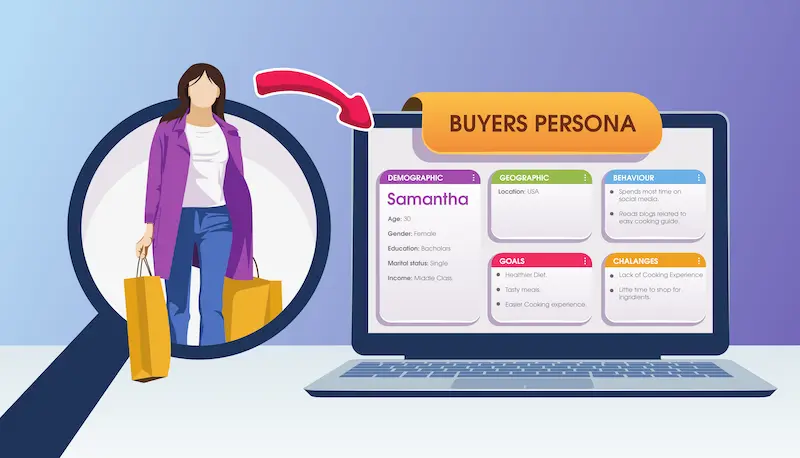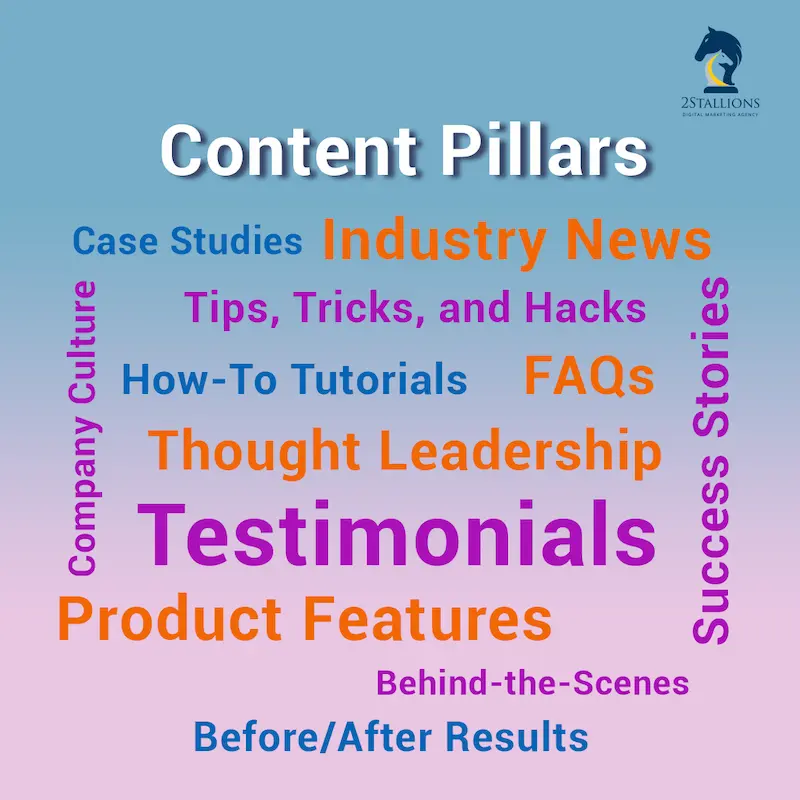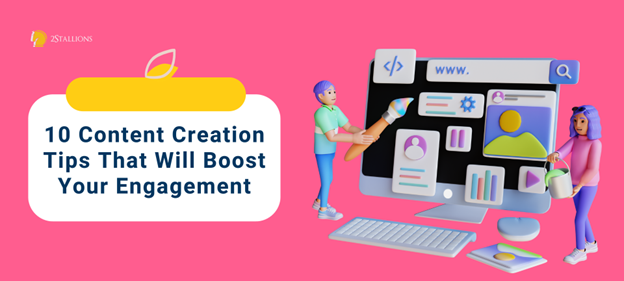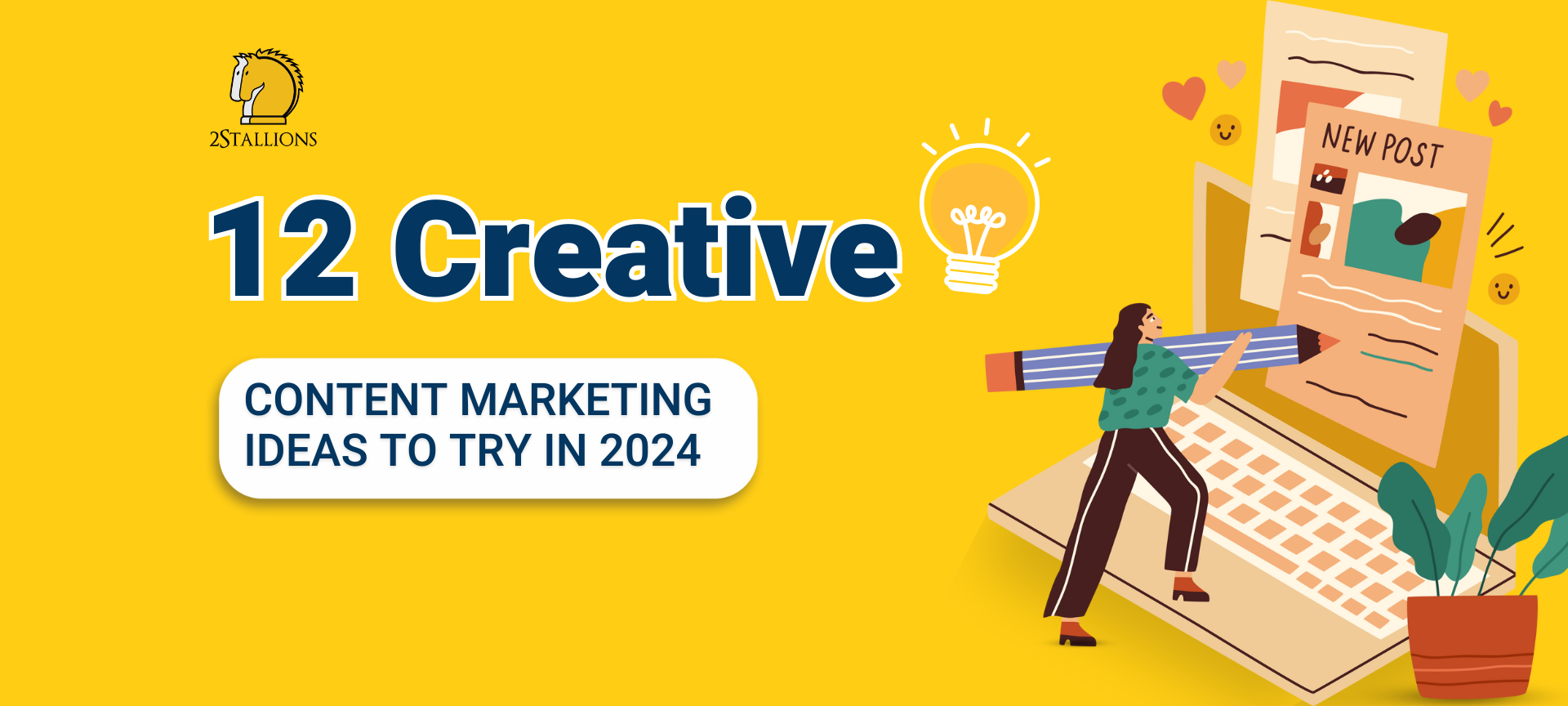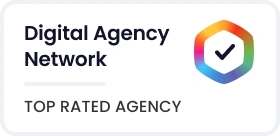SHARE
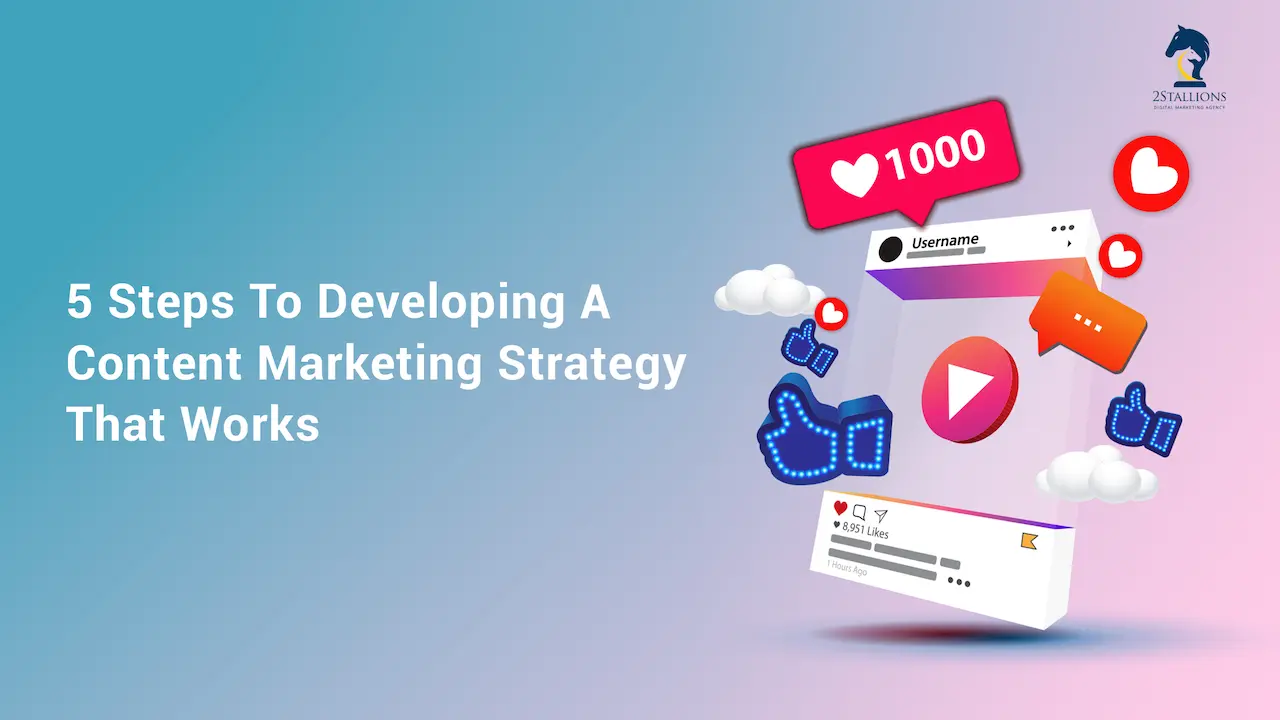
Creating content without seeing results often feels like shouting into an empty room. You invest time and resources into blog posts, social updates, and videos, only for them to get lost in the digital noise. This common challenge stems from a lack of a clear content marketing strategy.
The truth is, great content alone isn’t enough. What truly drives success is a strategic approach—one that aligns every piece of content with a clear purpose and measurable goals. A well-defined content marketing strategy transforms guesswork into precision, ensuring your efforts attract the right audience, generate qualified leads, foster customer loyalty, and significantly improve your return on investment. If you’re ready to stop guessing and start achieving, we have broken down how to create a content marketing strategy into five simple steps.
What is a Content Marketing Strategy?
A content marketing strategy is your long-term roadmap for creating and distributing valuable, relevant content. It’s designed to attract and engage your ideal audience by offering genuine solutions and insights, building trust, and driving profitable customer action, rather than simply pushing sales messages. It’s how your brand strategically tells its story to connect with customers at every stage.
A strong content marketing strategy isn’t just about getting more traffic; it’s about attracting the right audience, generating qualified leads, fostering customer loyalty, and significantly improving your return on investment. If you’re ready to stop guessing and start achieving, here are five actionable steps to develop a content strategy that works.
How to Create a Content Marketing Strategy
Step 1: Research & Define Your Audience
Before you write a single word or film a single video, you need to understand who you’re talking to. This foundational step is arguably the most crucial part of any effective content marketing strategy. Without a clear picture of your audience, your content will likely miss the mark.
Create Buyer Personas
These are semi-fictional representations of your ideal customers based on data and educated guesses. Go beyond basic demographics. Think about their:
- Demographics: Age, location, income, occupation.
- Psychographics: Values, interests, lifestyle, attitudes.
- Pain Points: What problems do they face that your product or service can solve?
- Goals & Motivations: What are they trying to achieve? What drives them?
- Information Sources: Where do they get their information? (e.g., social media, industry blogs, forums).
Conduct Audience Research
- Customer Surveys and Interviews: Directly ask your current customers and sales team to understand your customers’ needs and pain points. What specific challenges do your audience members face? What matters to them when considering different vendors in your industry. What questions do they frequently ask before purchasing? This knowledge will directly fuel your content ideas.
- Competitor Analysis: Review your competitors’ websites and social media profiles. Who are your competitors targeting? What kind of content resonates with their audience?
Align with Customer Journey Stages
After gathering some content ideas from the above sources, consider how your content fits into each stage of your customer’s journey:
- Awareness: Content that addresses broad pain points and introduces your brand.
- Consideration: Content that offers solutions, comparisons, and educates about your offerings.
- Decision: Content that builds trust, provides case studies, and drives conversions.
Step 2: Choose Content Channels and Formats
Selecting the right content formats and distribution channels is critical for reaching your audience effectively. Start by understanding where your target customers typically discover businesses similar to yours.
For instance, if you operate a B2B business and your customers frequently use search engines to find solutions, focus your efforts on producing informative blog posts and educational videos. These formats are highly discoverable on search engines and can drive valuable traffic to your website.
Conversely, for B2C businesses like restaurants or beauty brands, customers often discover new offerings through social media or influencer recommendations. In this scenario, prioritise engaging social media posts, short-form videos, and collaborations with relevant influencers.
Brainstorm Content Formats
Once you’ve identified your primary channels, determine the most effective content formats to engage your audience within those spaces. Consider a diverse range of options:
- Written Content: Blog posts, articles, eBooks, case studies, guides.
- Visual Content: Infographics, images, GIFs, presentations.
- Video Content: Tutorials, vlogs, interviews, product demos, webinars.
- Audio Content: Podcasts, audio blogs.
- Interactive Content: Quizzes, calculators, polls, interactive infographics.
- Short-form: Social media posts, stories, reels.
Define Your Content Pillars
Content pillars are the foundational themes your brand consistently creates content around. Think of them as the main categories on your blog, YouTube channel, or social media presence. Each pillar should speak directly to your audience’s needs and reflect your brand’s expertise or point of view.
These are some of the most commonly used types of content pillars:
- How-To Tutorials
- Success Stories
- Testimonials
- Behind-the-Scenes
- Company Culture
- Industry News
- Thought Leadership
- Product Features
- Tutorials
- Tips, Tricks, and Hacks
- User Highlights
- FAQs
- Case Studies
- Before/After Results
When done right, content pillars help you:
- Stay focused and strategic with your content.
- Build trust and authority in specific topic areas.
- Make it easier to brainstorm, plan, and repurpose content.
How to Identify Your Content Pillars
To find the right pillars for your brand, start by reviewing your typical customers. Ask yourself:
- What problems are they trying to solve?
- What kind of information are they actively looking for?
- Where does your brand offer a unique perspective, skillset, or experience?
- Your pillars should sit at the intersection of what your audience cares about and what your brand knows deeply.
Examples of Content Pillars
Let’s say you’re a fitness brand—your pillars might include:
- Nutrition for Performance
- Effective Workout Routines
- Mindfulness & Recovery
Or, if you’re a SaaS company, your content pillars could be:
- Software Integrations
- Productivity Hacks
- Industry Best Practices
Use these as inspiration, but make sure your own pillars are tailored to your audience’s unique questions and your brand’s expertise.
If you need expert assistance, 2Stallions is a trusted content marketing agency. We can help you develop compelling content strategies that boost your brand’s online presence. Learn more about our content marketing services or schedule a free consultation with us.
Step 4: Create Content Strategically
This is where your content marketing strategy comes to life. It’s not just about producing content; it’s about producing high-quality, optimised content that resonates with your audience and performs well on search engines.
Focus on value: Every piece of content you create should either educate, entertain, inspire, or solve a problem for your audience. Avoid creating content just for the sake of it. If it doesn’t provide value, it won’t engage your audience nor bring results.
Create a Content Calendar
A content calendar is your roadmap for consistency and organization. It ensures that you’re consistently publishing valuable content and that your team is aligned.
What to Include:
- Topic: The specific subject of the content piece.
- Format: Blog post, video, infographic, etc.
- Publishing Date: When the content will go live.
- Assigned Creator: Who is responsible for writing/designing/filming.
- Keywords: Target keywords for SEO (For website content).
- Call to Action (CTA): What do you want the audience to do next?
- Distribution Channels: On which platform will this content be published? (e.g., Facebook, LinkedIn, email newsletter).
Tools: Simple spreadsheets can work, but dedicated social media planning tools like Hootsuite, Later or specialized content marketing platforms can provide more robust features for team collaboration and tracking.
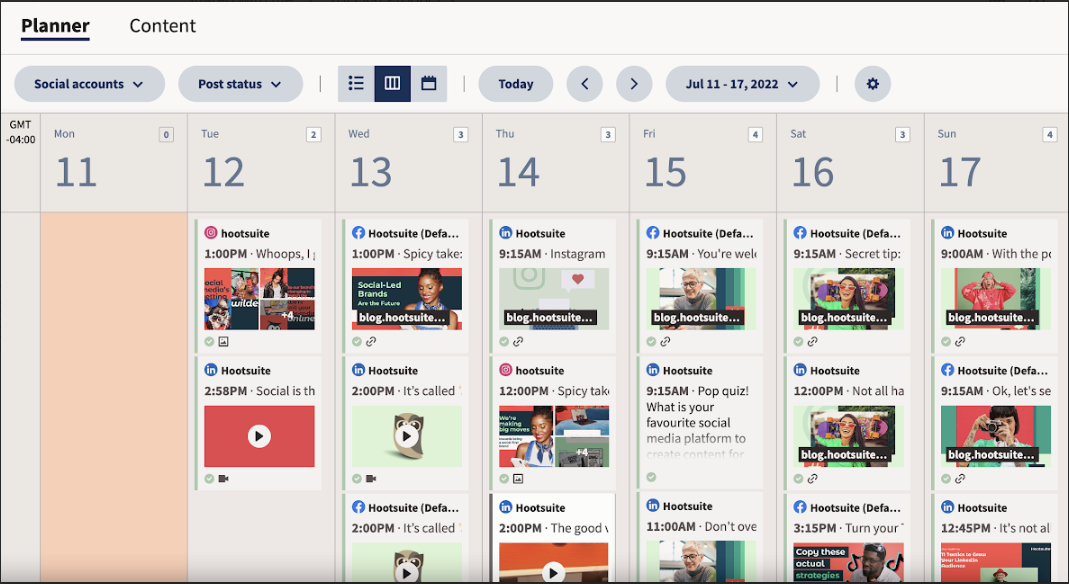
Source: Hootsuite
Tips for Blog & Website Content
Incorporate Basic Search Engine Optimisation (SEO)
To increase the chances of your content appearing in search engines and reaching more of your target audience, it is crucial to optimise your content for SEO. At the most basic level, use keyword tools such as Ahrefs or Ubersuggest to identify relevant keywords your audience is searching for. Use this information to plan the topics you will write about, and naturally weave these keywords into your content, headings, and meta descriptions – these are what appear in search results and are crucial for keyword inclusion.
Compelling Copywriting
Follow these tips to create engaging content that keeps your audience reading on:
- Strong Headlines: Hook your audience from the start.
- Clear, Concise Language: Get to the point. Avoid jargon where possible.
- Storytelling: People connect with stories. Weave narratives into your content.
- Strong Calls to Action (CTAs): Tell your audience what you want them to do next (e.g., “Download the eBook,” “Sign Up for Our Newsletter,” “Book a Demo”). Make them clear and prominent.
Include Visuals
Don’t underestimate the power of visuals. High-quality images, custom graphics, videos, and infographics make your content more engaging, shareable, and easier to digest.
Tips for Social Media Content
Social media thrives on immediate engagement and visual appeal.
- Be Concise and Visually Driven: Social media users scroll quickly. Use short, impactful text paired with eye-catching images or videos.
- Encourage Interaction: Ask questions, run polls, or create fill-in-the-blank posts to prompt comments and shares.
- Leverage Platform-Specific Features: Utilise features like Instagram Stories, LinkedIn polls, or TikTok sounds to create native and engaging content for each platform.
- Consistency is Key: Maintain a regular posting schedule to keep your audience engaged and grow your following.
- Adapt to Trends: Stay current with trending topics, sounds, and formats, but always ensure they align with your brand voice and message.
Repurpose Your Content
Maximize your efforts by repurposing content whenever possible. A detailed blog post can also become:
- A series of social media posts.
- An infographic.
- A short video script.
- Points for a podcast episode.
Step 5:Distribute, Promote & Analyse Your Content
Creating great content is only half the battle. Next, you need to get your content in front of your target audience and then analyze its performance to continually improve.
Multi-Channel Distribution
Don’t just publish on one channel and hope for the best. Actively distribute your content across multiple channels where your audience spends their time.
- Social Media: Promote your blog post or other content across relevant social media platforms (Facebook, Instagram, LinkedIn, X, TikTok, etc.). Adapt your post copy and visuals for each platform.
- Influencer Collaborations: Partner with influencers who can share your content with their audience.
- Email Marketing: Promote new content as part of your newsletter to subscribers.
- Guest Posting/Syndication: Reach out to relevant industry slides to publish your content and reach new audiences.
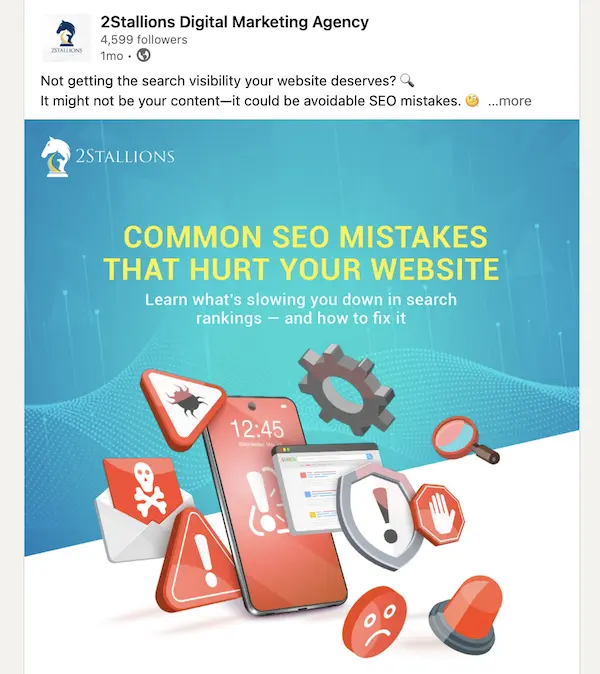
2Stallions Post on LinkedIn
Analyze Performance
Regularly track key metrics to understand what’s working and what needs adjustment. The most common tracking platforms include Google Analytics, Google Search Console, the insights section of your social media platforms, email marketing platform reports to SEO tools (like Semrush, Ahrefs).
- Social Media Engagement Rates: Likes, shares, comments, video views, download counts. These can usually be found from the ‘Analytics’ or ‘Insights’ section of the social media platforms
- Page Traffic: The number of visitors or views your content page is receiving, the number of clicks it receives from organic search (e.g., via Google Analytics, Google Search Console).
- Search Rankings: The position your content is appearing in search engine results for your target keywords.

Source: Sprout Social
Iterate and Optimize
Your content marketing strategy is not a static document. It’s a living plan. Use the data you collect to:
- Identify Top Performers: What content formats or topics resonate most? Create more of those!
- Pinpoint Underperformers: Why isn’t certain content working? Is it the topic, format, promotion, or optimization?
- Test: Experiment with different headlines, CTAs, visuals, or content formats to see what yields better results and scale what’s working.
- Content Audits: Periodically review your existing content to update, improve, or remove outdated pieces.
Conclusion
Developing a content marketing strategy might seem like a daunting task, but by breaking it down into these five actionable steps, you can build a powerful framework that drives real results for your business. From understanding your audience to setting clear goals, crafting valuable content, and then promoting and analyzing its performance, each step builds upon the last, creating a cohesive and effective approach.
Remember, content marketing is not a one-time project; it’s an ongoing process of creation, distribution, learning, and adaptation. By committing to these steps, you’ll transform your content from a chaotic effort into a strategic asset that consistently attracts, engages, and converts your ideal customers.
Ready to transform your content from a guessing game to a strategic powerhouse? Start implementing these steps today and watch your business thrive.
If you need expert assistance, learn more about our content marketing services or book a complimentary consultation with our expert team.
2 Stallions: Who We Are
2Stallions is an award-winning, full-service digital marketing agency with offices in Singapore and Malaysia. Since 2012, we’ve helped brands of all sizes turn strategy into growth through SEO services, SEM services, social media marketing services, content marketing services, to website design and development.
Need funding support? We’ve got that covered too. 2Stallions is a pre-approved vendor for the PSG Digital Marketing Grant, allowing eligible Singaporean SMEs to claim up to 50% off our services. We are also vendors of the Digi-TAC Grant.
Our results-oriented approach has earned us various industry accolades, from the Marketing Excellence Awards, Asia eCommerce Awards to the Drum Awards for Digital Advertising APAC. We’re also certified partners with Google, TikTok, and Shopify, giving you direct access to the tools, insights, and support that drive real digital performance.
Let’s grow your business. Book a free strategy consultation and get your custom roadmap to digital success.


